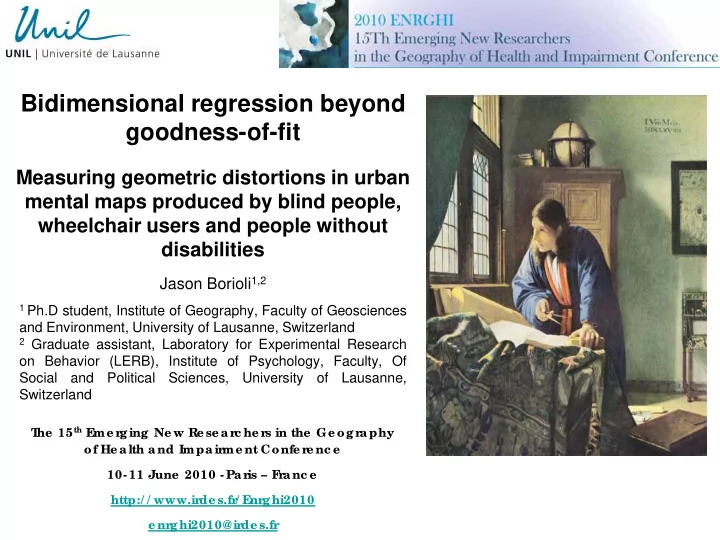

Bidimensional regression beyond goodness-of-fit Measuring geometric distortions in urban mental maps produced by blind people, wheelchair users and people without disabilities Jason Borioli 1,2 1 Ph.D student, Institute of Geography, Faculty of Geosciences and Environment, University of Lausanne, Switzerland 2 Graduate assistant, Laboratory for Experimental Research on Behavior (LERB), Institute of Psychology, Faculty, Of Social and Political Sciences, University of Lausanne, Switzerland he 15 th E T me r ging Ne w Re se ar c he r s in the Ge ogr aphy of He alth and Impair me nt Confe r e nc e 10- 11 June 2010 - Par is – F r anc e http:/ / www.ir de s.fr / E nr ghi2010 e nr ghi2010@ir de s.fr
Outline • Bidimensional regression: general presentation • Conceptual bases • Goodness-of-fit vs geometric transformations • Geographical applications: urban mental maps • Discussion
Bidimensional regression • Assess the similarity between two-dimensional data sets • Regression analysis and two-dimensional coordinate transformation models • Tobler introduced it to the geography literature [1965, 1966, 1978, 1994]. Was later introduced to the psychology [Friedman & Kohler, 2003] and computer-science literatures [Kare et al ., 2008]
Conceptual bases Y y i = ax i + b + e i e i = y i − ax i − b e i n n ∑ ∑ ( ) ( ) 2 2 S = = y i − ax i − b e i i = 1 i = 1 X
Conceptual bases 15 4 2 15 4 f i 13 15 2 13 4 e i 6 13 1 6 2 1 11 10 6 1 11 14 11 9 9 10 7 10 9 14 7 14 n ( ) 2 + f i 3 S 2 = 5 ∑ ( ) 2 5 7 3 e i 3 i = 1 8 12 8 12 8 5 12
Conceptual bases General definition of bidimensional regression * = Α xi ui = Α xi + ei → ui * yi vi yi fi vi u i , v i = observed coordinates (i.e. dependent coordinates) A = coordinate transformation matrix x i , y i = reference coordinates (i.e. independent coordinates) e i , f i = residuals * = predicted coordinates * , v i u i
Conceptual bases Euclidean transformation: A=4 parameters Affine transformation: A=6 parameters Affine transformation: A=6 parameters Projective transformation: A=8 parameters Projective transformation: A=8 parameters Curvilinear transformation: A=x parameters Curvilinear transformation: A=x parameters
Conceptual bases Euclidean transformation: A=4 parameters − a 2 → u * = a 1 x + b 1 v * a 2 a 1 y b 2 = s cos θ − s sin θ → u * x + b 1 s sin θ s cos θ v * y b 2
Geometric transformations Scale 2 10 • • tx=2 ty=3 • • • tx=2 5 45 ° ty=3 • • Scale 2 45 ° • • • • • 1 5 10 15 1
Geometric transformations 1. Scale - rotation - translation = rotation - scale - translation − a 2 s cos θ − s sin θ a 1 b 1 tx → s sin θ s cos θ a 2 a 1 b 2 ty 0 0 1 0 0 1 2. Rotation - translation - scale − a 2 s cos θ − s sin θ a 1 b 1 stx → s sin θ s cos θ a 2 a 1 b 2 sty 0 0 1 0 0 1 3. Scale - translation - rotation − a 2 s cos θ − s sin θ tx cos θ − ty sin θ a 1 b 1 → s sin θ s cos θ tx sin θ + ty cos θ a 2 a 1 b 2 0 0 1 0 0 1 4. Translation - scale - rotation = translation - rotation - scale − a 2 s cos θ − s sin θ stx cos θ − sty sin θ a 1 b 1 → s sin θ s cos θ stx sin θ + sty cos θ a 2 a 1 b 2 0 0 1 0 0 1
Urban mental maps
Urban mental maps 4 15 * − a 2 13 = a 1 xi + b 1 ui * a 2 a 1 yi b 2 vi 6 2 11 10 a1=0.86, p=.000 1 14 9 7 a2=0.14, p=.348 3 b1=-5.32, p=.837 8 b2=36.63, p=.164 5 12 R2=0.57, p=.000
Urban mental maps 1. Scale - rotation - translation = rotation - scale - translation scale=0.87, p=0.364; rotation=-9.31 ° , p=.000; tx=-5.32 , p=.823; ty=36.63 , p=.124 2. Rotation - translation - scale scale=0.87, p=0.364; rotation=-9.31 ° , p=.000; tx=-6.09 , p=.817; ty=41.88 , p=.164 3. Scale - translation - rotation scale=0.87, p=0.364; rotation=-9.31 ° , p=.000; tx=-11.18 , p=.677; ty=35.28 , p=.115 4. Translation - scale - rotation = translation - rotation - scale scale=0.87, p=0.364; rotation=-9.31 ° , p=.000; tx=-12.78 , p=.662; ty=40.33 , p=.168
Urban mental maps Transformation order ( ) = 9.394, p = .153 2 6 χ RST(SRT) RTS STR TRS(TSR) Blind people 3 2 3 6 (n =14) Wheelchair users Group 5 3 3 3 (n =14) Non-impaired 3 4 5 2 (n =14)
Discussion • Algebraic vs geometric parameters • No a priori order • “Preferential“ transformation orders • http://spatial-modelling.info/Darcy-2-module-de-comparaison
Thank you for your attention
Recommend
More recommend